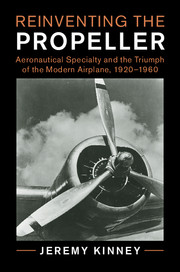Book contents
- Frontmatter
- Dedication
- Contents
- List of Figures
- List of Tables
- Preface
- Acknowledgments
- List of Abbreviations
- A Note on Terms
- 1 Introduction: The Propeller and the Modern Airplane
- 2 “The Best Propeller for Starting Is Not the Best for Flying”
- 3 “Engineering of a Pioneer Character”
- 4 A “New Type Adjustable-Pitch Propeller”
- 5 “The Propeller That Took Lindbergh Across”
- 6 “The Ultimate Solution of Our Propeller Problem”
- 7 No. 1 Propeller Company
- 8 A Gear Shift for the Airplane
- 9 Constant-Speed
- 10 “The Spitfire Now ‘Is an Aeroplane’ ”
- 11 A Propeller for the Air Age
- 12 Conclusion: The Triumph and Decline of the Propeller
- Essay on Sources
- Index
2 - “The Best Propeller for Starting Is Not the Best for Flying”
Published online by Cambridge University Press: 20 April 2017
- Frontmatter
- Dedication
- Contents
- List of Figures
- List of Tables
- Preface
- Acknowledgments
- List of Abbreviations
- A Note on Terms
- 1 Introduction: The Propeller and the Modern Airplane
- 2 “The Best Propeller for Starting Is Not the Best for Flying”
- 3 “Engineering of a Pioneer Character”
- 4 A “New Type Adjustable-Pitch Propeller”
- 5 “The Propeller That Took Lindbergh Across”
- 6 “The Ultimate Solution of Our Propeller Problem”
- 7 No. 1 Propeller Company
- 8 A Gear Shift for the Airplane
- 9 Constant-Speed
- 10 “The Spitfire Now ‘Is an Aeroplane’ ”
- 11 A Propeller for the Air Age
- 12 Conclusion: The Triumph and Decline of the Propeller
- Essay on Sources
- Index
Summary
Aviation journalist Carl Dienstbach traveled to Dayton in July 1905 to interview the world's leading aeronautical technologists. Beginning in 1896, Wilbur and Orville worked to invent the first airplane through a synergy of the technical systems of lift, control, structures, and propulsion, which culminated in the December 17, 1903 flight of their Flyer at Kitty Hawk, North Carolina. In the process, Wilbur and Orville created the first practical, efficient, and purpose-built aerial propellers and a design theory to support them. Acknowledging their ability to design an efficient propeller according to their aerodynamic principles, Wilbur still recognized the limitations of their invention. He informed Dienstbach that “the best propeller for starting is not the best for flying.” The elder Wright's statement highlighted the fact that the technology that turned the engine's power into thrust and enabled aircraft to take to the air was far from meeting the needs of aviation.
The Wrights were the leading members of a distinct community of American and European technologists that created the airplane in the late nineteenth century. Their efforts provided the basis from which modern flight evolved. They chose the wood, fixed-pitch propeller as its standard through their adherence to the already established design paradigms of light weight and simplicity. At the same time, this early flight community took the Wrights’ original creation and attempted to change its composition as well as its ability to alter pitch.
The Early History of the Propeller
The idea of how an airplane propeller might work existed for centuries in human history. The Greek mathematician and engineer Archimedes described a method of transporting water uphill through the helical motion of his “water screw” during the third century BCE. The emergence of propeller-like windmills in Western Europe in the twelfth century CE indicated a reverse understanding of the principles and capabilities of thrust. Their builders used wind-driven wood-framed and fabric-covered blades, called sails, to create power for agricultural purposes. The inventor-philosopher-artist Leonardo da Vinci sketched an “aerial screw” in the late fifteenth century that was a precursor of the helicopter. Though mainly conceptual, these ideas influenced the development of both marine and aerial propellers. Seagoing ships, lighter-than-air balloons and airships, and the fanciful flying machines from the late eighteenth and nineteenth centuries all featured various forms of propellers.
- Type
- Chapter
- Information
- Reinventing the PropellerAeronautical Specialty and the Triumph of the Modern Airplane, pp. 16 - 44Publisher: Cambridge University PressPrint publication year: 2017



